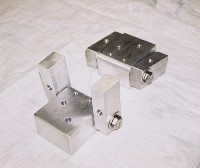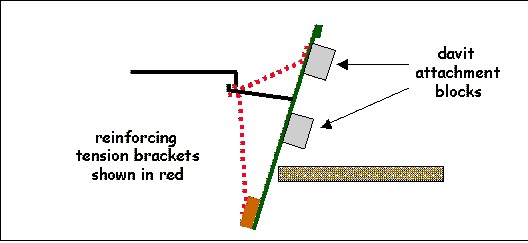By Rob Farrow
I was looking for a better way to carry the dinghy than hoisting it up on to the cabin roof each time. (which we did for years) I did not care for the look (or the cost) of the commercially available davit systems and since I like the challenge of a complex woodworking project, this came together as a set of arched, laminated wooden dinghy davits. The davits and block system are easily strong enough to lift and carry the dinghy with its 9.9 in place, although we usually choose to carry the dinghy without the motor. On the rare occasion that we do leave the motor on the dinghy, I have a temporary steel cable which runs from the tip of the motor end davit to an eye located forward on the aft deck. This stops any “bounce” in heavy swells.

Once lifted into carrying position, two small lines are used to snug the dinghy against rubber bumpers on the underside of the wooden arches, to prevent it from swinging.
The davit arms are constructed from ¼” layers of Ash, with small mahogany inserts along the edge of every second laminate for contrast. The laminates were cut from rough stock using a band saw & planer and laminated with West System Epoxy by clamping them over a curved frame.

Inside one of the laminate layers, I ran wires out to the end of each davit. A small pair of lights shining down on the swimgrid are a great asset during those late night dinghy dockings
Click on image for larger picture
The davits are designed to fold outward when not in use. (Although we find that we rarely have cause to do this)


The arms are attached to the hull using hinges made from blocks of aluminum. Aluminum can be worked with appropriate bits and blades in woodworking tools, so is well suited to this project.
  |
 |
The upper davit attachment to the transom is reinforced on the inside with a two piece tension bracket which carries the load to the deck and then down to the wooden structure reinforcing the transom, without creating a path for water to enter. (In concept, this works like mast stays held out from the mast by a midpoint spreader.)

I also made by own blocks (because I like to do this kind of thing) but any commercially available block system could be used.

Powering into 25 knots of wind . . . . . . with the dinghy securely attached
(unfortunately, the starboard antenna with the pennant, parted company with the boat . . . . shortly after this picture was taken)

Rob Farrow
Catherine Ann
February 2007
rob.farrow@sympatico.ca

